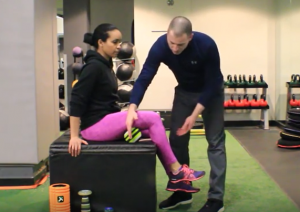
The Brookbush Institute Announces a New Multi-media Course on the Biceps Femoris
Finally, a Biceps Femoris course that covers all facets of functional anatomy, and is delivered in a variety of learning formats.
This course provides detailed descriptions of etymology, attachments, innervations, joint actions, location, palpation, integrated actions, arthrokinematics, fascial integration, subsystem integration, postural dysfunction, assessment, clinical implications, and interventions.
And, this course includes a variety of formats and study aids to fit the learner's preferences and schedule needs.
- Webinar
- Study Guide
- Text and Illustrations
- Audio Voice-over
- Research Review
- Technique Videos
- Case Study and Sample Routine
- Practice Exam
- 3 Credit Final Exam
INTRODUCTION from "Biceps Femoris"
(from "Muscle Anatomy" at BrookbushInstitute.com)
Structure:
This course describes the anatomy and integrated function of the biceps femoris muscle group (a.k.a. the hamstrings, lateral hamstrings, leg biceps, posterior thigh muscles, etc.). This muscle includes two heads, the long head crosses the hip and knee, and the short head crosses only the knee. Both heads are located within the posterior fascial compartment of the thigh, between the lateral and medial intermuscular septa, abutting the lateral intermuscular septum. Research suggests the biceps femoris only accounts for about 3.9% of the total muscle mass of the thigh and is composed of primarily type I muscle fibers.
Function
Both heads perform similar functions at the knee joint, but only the long head crosses the hip joint. Both heads of the biceps femoris are considered the prime mover during knee flexion and tibial external rotation, and the long head of the biceps femoris is a synergist during hip extension and hip external rotation. This course also describes the role of the biceps femoris on knee joint, hip joint, and sacroiliac joint (SIJ) arthrokinematics, fascial integration (sacrotuberous ligament), subsystem integration, and postural dysfunction. For example, the long head of the biceps femoris is part of the deep longitudinal subsystem (DLS), which may increase tension in the sacrotuberous ligament, increasing the stiffness of the SIJ (restricting nutation). If the biceps femoris and DLS are over-active, this could excessively increase SIJ stiffness, contributing to an asymmetrical weight shift during an overhead squat assessment and postural dysfunction (e.g., movement impairment) of the lumbopelvic hip complex and/or lower extremity.
Practical Application:
Sports medicine professionals (personal trainers, fitness instructors, physical therapists, massage therapists, chiropractors, occupational therapists, athletic trainers, etc.) must be aware of the integrated function of the biceps femoris for the detailed analysis of human movement, and the development of sophisticated exercise programs and therapeutic (rehabilitation) interventions. For example, altered activity and length of the biceps femoris may contribute to hip pain, hamstring injury, hamstring muscle strain, hip joint impingement, low back pain, knee valgus, knee varus, and knee pain. Altered biceps femoris activity may also result in a relative reduction in gluteus maximus and gluteus medius activity, resulting in a significant decrease in lower body speed, agility, and strength, and a reduction in the effectiveness of resistance training routines intended to improve lower body strength and hypertrophy (bodybuilding). Deeper knowledge of biceps femoris anatomy is essential for optimal assessment, intervention selection, and building a repertoire of biceps femoris-specific techniques.
Check out the case study, technique videos, and so much more by following the link to the new course: Biceps Femoris
Brent Brookbush
Brookbush Institute
Media@BrookbushInstitute.com
Visit us on social media:
Facebook
Twitter
LinkedIn
Instagram
YouTube
TikTok
EIN Presswire does not exercise editorial control over third-party content provided, uploaded, published, or distributed by users of EIN Presswire. We are a distributor, not a publisher, of 3rd party content. Such content may contain the views, opinions, statements, offers, and other material of the respective users, suppliers, participants, or authors.


